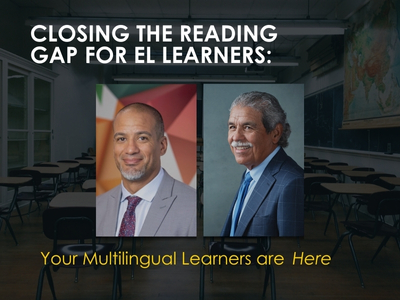Overcoming the New Challenges of Teaching Multilingual Learners
Watch the RecordingListen to the Podcast
As new arrivals continue to increase the numbers of English language learners in school districts across America, educators are also adapting to the changes in instruction based on the Science of Reading, which may be further complicated in some school districts by shortages in the number of certified teachers.
Two experienced leaders of major school districts shared their recommendations for continuing to improve the achievement of multilingual learners during the edLeader Panel “Closing the Reading Gap for EL Learners: Your Multilingual Learners Are Here.” Dr. Michael Hinojosa is currently the Superintendent in Residence at the Council of Great City Schools and Texas Urban Council and previously was the Superintendent of Dallas ISD in Texas and Cobb County School District in Atlanta, Georgia. Dr. Tony Smith is currently the Deputy Superintendent of the Denver Public Schools.
In Dallas, almost half the students have been classified as English learners, a total of about 70,000 students, so as Dr. Hinojosa noted, the district cannot be successful if so many students don’t do well. Meanwhile, Denver has also had a large, longstanding population of English learners, and recently the city has been attracting many newly arrived immigrants, with several thousand English learners having entered the school system in just the last few months.
According to Dr. Hinojosa and Dr. Smith, overcoming the current combination of challenges requires a consistent and coherent approach that includes curriculum modification, ongoing educator development, and building partnerships with parents and other community members.
Augmenting the Curriculum
Dr. Hinojosa emphasized the importance of optimizing a curriculum based on the Science of Reading so that it is applicable and effective for English learners. He pointed out that certain sounds in languages such as Spanish are not included in standard English phonemic awareness instruction, and some teachers may have accents that complicate the teaching and learning of sound-symbol correspondence. If not addressed, this can result in gaps in achievement.
Dr. Hinojosa also noted that accurate and ongoing assessment is needed to make sure literacy gaps do not develop, and oral language assessment, in particular, can be challenging with English learners, because many of them tend to stay quiet in class and not say much.
In Denver, according to Dr. Smith, transitional native language programs help to address the assessment issue by enabling students to “show their brilliance.” He added that using context to support overall language development, rather than just focusing on skill development, is also important because so many multilingual learners are bright and need opportunities to demonstrate their competence and continue improving.
Supporting and Attracting Teachers
In order for educators to adapt their teaching and materials to the needs of diverse multilingual learners, Dr. Smith believes time needs to be allocated during the school day to review and discuss student data. Amidst all the other work educators need to do, there also has to be time for teachers to talk with the students and communicate with their families in order to understand their learning needs and the types of support that should be provided.
Having a district team that “wraps support around teachers” has been crucial in Denver, according to Dr. Smith. This includes having expert teachers model instruction and then coach and support other teachers side by side in their schools, as well as considering teachers to be “thought partners” who can explain where they are seeing issues with the curriculum and professional development.
In addition to providing professional development for current staff members, the district has been providing stipends and support for classroom teachers to become certified teachers of English as a new language. As the district has many paraprofessionals who are already bilingual, those educators can receive support in obtaining teaching licenses. Meanwhile, the district has also been recruiting and sponsoring teachers from other countries, especially South America.
Building Partnerships
In Denver, community partnerships have been important in providing support, especially in regard to the full range of needs that newly arrived students and their families may have. Community hubs focus on working through Maslow’s Hierarchy of Needs, so students can come to school ready to learn and be less distracted by other concerns.
In Dallas, Dr. Hinojosa expanded the district’s partnership with parents to include children under the age of four. Knowing that some young children had no access to books in their homes, the district began providing books and other early childhood education materials to parents as part of a “Start Strong” program, which encouraged reading, talking, and playing with children to support their development and build knowledge in an age-appropriate way.
By encouraging these types of partnerships and overlapping proven methods with research-based innovations, districts can continue to increase the achievement of their current multilingual learners while preparing for new arrivals in the future.
Learn more about this edWeb broadcast, Closing the Reading Gap for EL Learners: Your Multilingual Learners Are Here, sponsored by Really Great Reading.
Watch the RecordingListen to the Podcast
Join the Community
Structured Literacy Instruction is a free professional learning community that champions literacy education, catering to educators, school leaders, and district administrators alike.

Article by Robert Low, based on this edLeader Panel





Comments are closed.